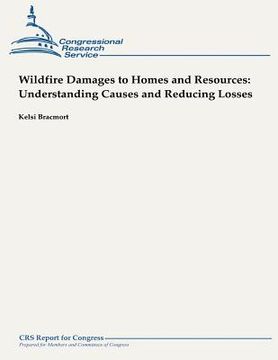Wildfire Damages to Homes and Resources: Understanding Causes and Reducing Losses (en Inglés)
Reseña del libro "Wildfire Damages to Homes and Resources: Understanding Causes and Reducing Losses (en Inglés)"
Wildfires are getting more severe, with more acres and houses burned and more people at risk. This results from excess biomass in the forests, due to past logging and grazing and a century of fire suppression, combined with an expanding wildland-urban interface-more people and houses in and near the forests-and climate change, exacerbating drought and insect and disease problems. Some assert that current efforts to protect houses and to reduce biomass (through fuel treatments, such as thinning) are inadequate, and that public objections to some of these activities on federal lands raise costs and delay action. Others counter that proposals for federal lands allow timber harvesting with substantial environmental damage and little fire protection. Congress is addressing these issues through various legislative proposals and through funding for protection programs. Wildfires are inevitable-biomass, dry conditions, and lightning create fires. Some are surface fires, which burn needles, grasses, and other fine fuels and leave most trees alive. Others are crown fires, which are typically driven by high winds and burn biomass at all levels from the ground through the tree tops. Many wildfires contain areas of both surface and crown fires. Surface fires are relatively easy to control, but crown fires are difficult, if not impossible, to stop; often, crown fires burn until they run out of fuel or the weather changes. Homes can be ignited by direct contact with fire, by radiative heating, and by firebrands (burning materials lifted by the wind or the fire's own convection column). Protection of homes must address all three. Research has identified the keys to protecting structures: having a nonflammable roof; clearing burnable materials that abut the house (e.g., plants, flammable mulch, woodpiles, wooden decks); and landscaping to create a defensible space around the structure. Wildland and resource damages from fire vary widely, depending on the nature of the ecosystem as well as on site-specific conditions. Surface fire ecosystems, which burn on 5- to 35-year cycles, can be damaged by crown fires due to unnatural fuel accumulations and fuel ladders (small trees and dense undergrowth); fuel treatments probably prevent some crown fires in such ecosystems. Stand-replacement fire ecosystems are those where crown fires are natural and the species are adapted to periodic crown fires; fuel treatments are unlikely to alter the historic fire regime of such ecosystems. In mixed-intensity fire ecosystems, where a mix of surface and crown fires is historically normal, it is unclear whether fuel treatments would alter wildfire patterns. Prescribed burning (intentional fires) and mechanical treatments (cutting and removing some trees) can reduce resource damages caused by wildfires in some ecosystems. However, prescribed fires are risky, mechanical treatments can cause other ecological damages, and both are expensive. Proponents of more treatment advocate expedited processes for environmental and public review of projects to hasten action and cut costs, but others caution that inadequate review can allow unintended damages with few fire protection benefits.

